Rice Husk Ash-Based Geopolymer Binder: Compressive Strength, Optimize Composition, FTIR Spectroscopy, Microstructural, and Potential as Fire-Retardant Material †
Abstract
:1. Introduction
2. Materials and Methods
2.1. Factors and Levels of the Design of Experiment (DOE)
2.2. Design of Experiment
2.3. Raw Materials and Sample Preparation
2.4. Compressive Strength Test
2.5. Fire-Retardant Test
2.6. Microstructure of Rice Husk Ash
2.7. Fourier Transform Infrared Spectroscopy (FTIR)
3. Results and Discussion
3.1. Statistical Analysis of Compressive Strength
3.2. Effect of Factors on Compressive Strength
3.3. Optimization of the Responses
3.4. Experimental Validation
3.5. Material Behavior and Microstructural Analysis
3.5.1. Microstructural Analysis
3.5.2. Material Behavior
3.6. FTIR Spectroscopy Characterization
3.7. Potential as Fire-Retardant Material
4. Conclusions
Author Contributions
Funding
Institutional Review Board Statement
Informed Consent Statement
Data Availability Statement
Acknowledgments
Conflicts of Interest
References
- Komnitsas, K.; Zaharaki, D. Geopolymerisation: A review and prospects for the minerals industry. Miner. Eng. 2007, 20, 1261–1277. [Google Scholar] [CrossRef]
- De Silva, P.; Sagoe-Crenstil, K.; Sirivivatnanon, V. Kinetics of geopolymerization: Role of Al2O3 and SiO2. Cem. Concr. Res. 2007, 37, 512–518. [Google Scholar] [CrossRef]
- Songpiriyakij, S.; Kubprasit, T.; Jaturapitakkul, C.; Chindaprasirt, P. Compressive strength and degree of reaction of biomass-and fly ash-based geopolymer. Constr. Build. Mater. 2010, 24, 236–240. [Google Scholar] [CrossRef]
- Fletcher, R.A.; MacKenzie, K.J.; Nicholson, C.L.; Shimada, S. The composition range of aluminosilicate geopolymers. J. Eur. Ceram. Soc. 2005, 25, 1471–1477. [Google Scholar] [CrossRef]
- Luna Galiano, Y.; Cornejo, A.; Leiva Fernández, C.; Vilches Arenas, L.F.; Fernández Pereira, C. Properties of fly ash and metakaolín based geopolymer panels under fire resistance tests. Mater. De Constr. 2015, 65, 1–13. [Google Scholar] [CrossRef] [Green Version]
- Madejska, L.; Jarosiński, A.; Żelazny, S.; Kusnierova, M.; Chachlowska, M. Properties of geopolymer binder obtained from fly ash. Czas. Techniczne. Chem. 2011, 108, 113–118. [Google Scholar]
- Kozub, B.; Bazan, P.; Mierzwiński, D.; Korniejenko, K. Fly-Ash-Based Geopolymers Reinforced by Melamine Fibers. Materials 2021, 14, 400. [Google Scholar] [CrossRef]
- Kamarudin, H.; Al Bakri, A.; Binhussain, M.; Ruzaidi, C.; Luqman, M.; Heah, C.; Liew, Y. Preliminary study on effect of NaOH concentration on early age compressive strength of kaolin-based green cement. In Proceedings of the International Conference on Chemistry and Chemical Process IPCBEE, Singapore, 18–24 October 2011; pp. 18–24. [Google Scholar]
- Buchwald, A.; Vicent, M.; Kriegel, R.; Kaps, C.; Monzó, M.; Barba, A. Geopolymeric binders with different fine fillers—Phase transformations at high temperatures. Appl. Clay Sci. 2009, 46, 190–195. [Google Scholar] [CrossRef]
- Le, V.S.; Louda, P.; Tran, H.N.; Nguyen, P.D.; Bakalova, T.; Ewa Buczkowska, K.; Dufkova, I. Study on Temperature-Dependent Properties and Fire Resistance of Metakaolin-Based Geopolymer Foams. Polymers 2020, 12, 2994. [Google Scholar] [CrossRef]
- Cheng, T.-W.; Chiu, J. Fire-resistant geopolymer produced by granulated blast furnace slag. Miner. Eng. 2003, 16, 205–210. [Google Scholar] [CrossRef]
- Mathur, A.; Singh, U.; Vijay, Y.; Hemlata, M.S.; Sharma, M. Analysing performance for generating power with renewable energy source using rice husk as an alternate fuel. Control. Theory Inform. 2013, 3, 64–71. [Google Scholar]
- Omatola, K.; Onojah, A. Rice Husk as a Potential Source of High Technology Raw Materials: A Review. J. Phys. Sci. Innov. 2012, 4, 1–6. [Google Scholar]
- Sun, L.; Gong, K. Silicon-based materials from rice husks and their applications. Ind. Eng. Chem. Res. 2001, 40, 5861–5877. [Google Scholar] [CrossRef]
- Mohd Basri, M.S.; Mustapha, F.; Mazlan, N.; Ishak, M.R. Optimization of Adhesion Strength and Microstructure Properties by Using Response Surface Methodology in Enhancing the Rice Husk Ash-Based Geopolymer Composite Coating. Polymers 2020, 12, 2709. [Google Scholar] [CrossRef] [PubMed]
- Basri, M.S.M.; Mazlan, N.; Mustapha, F.; Ishak, M.R. Correlation between compressive strength and fire resistant performance of rice husk ash-based geopolymer binder for panel applications. In Proceedings of the MATEC Web of Conferences, Taichung, China, 28 October–1 November 2016; p. 01025. [Google Scholar]
- Buyondo, K.A.; Olupot, P.W.; Kirabira, J.B.; Yusuf, A.A. Optimization of production parameters for rice husk ash-based geopolymer cement using response surface methodology. Case Stud. Constr. Mater. 2020, 13, e00461. [Google Scholar] [CrossRef]
- Givi, A.N.; Rashid, S.A.; Aziz, F.N.A.; Salleh, M.A.M. Assessment of the effects of rice husk ash particle size on strength, water permeability and workability of binary blended concrete. Constr. Build. Mater. 2010, 24, 2145–2150. [Google Scholar] [CrossRef]
- Mohd Basri, M.S.; Yek, T.H.; A Talib, R.; Mohamed Amin Tawakkal, I.S.; Kamarudin, S.H.; Mazlan, N.; Maidin, N.A.; Ab Rahman, M.H. Rice Husk Ash/Silicone Rubber-Based Binary Blended Geopolymer Coating Composite: Fire Retardant, Moisture Absorption, Optimize Composition, and Microstructural Analysis. Polymers 2021, 13, 985. [Google Scholar] [CrossRef]
- Czitrom, V. One-factor-at-a-time versus designed experiments. Am. Stat. 1999, 53, 126–131. [Google Scholar]
- Box, G.E.; Wilson, K.B. On the experimental attainment of optimum conditions. In Breakthroughs in Statistics; Springer: Berlin/Heidelberg, Germany, 1992; pp. 270–310. [Google Scholar]
- Czyrski, A.; Jarzębski, H. Response Surface Methodology as a Useful Tool for Evaluation of the Recovery of the Fluoroquinolones from Plasma—The Study on Applicability of Box-Behnken Design, Central Composite Design and Doehlert Design. Processes 2020, 8, 473. [Google Scholar] [CrossRef]
- Flaifel, M.H. An Approach Towards Optimization Appraisal of Thermal Conductivity of Magnetic Thermoplastic Elastomeric Nanocomposites Using Response Surface Methodology. Polymers 2020, 12, 2030. [Google Scholar] [CrossRef] [PubMed]
- Hassan, M.Z.; Roslan, S.A.; Sapuan, S.; Rasid, Z.A.; Mohd Nor, A.F.; Md Daud, M.Y.; Dolah, R.; Mohamed Yusoff, M.Z. Mercerization Optimization of Bamboo (Bambusa vulgaris) Fiber-Reinforced Epoxy Composite Structures Using a Box–Behnken Design. Polymers 2020, 12, 1367. [Google Scholar] [CrossRef] [PubMed]
- Azeem, B.; KuShaari, K.; Naqvi, M.; Kok Keong, L.; Almesfer, M.K.; Al-Qodah, Z.; Naqvi, S.R.; Elboughdiri, N. Production and Characterization of Controlled Release Urea Using Biopolymer and Geopolymer as Coating Materials. Polymers 2020, 12, 400. [Google Scholar] [CrossRef] [Green Version]
- Chen, Y.; Wang, F.; Dong, L.; Li, Z.; Chen, L.; He, X.; Gong, J.; Zhang, J.; Li, Q. Design and optimization of flexible polypyrrole/bacterial cellulose conductive nanocomposites using response surface methodology. Polymers 2019, 11, 960. [Google Scholar] [CrossRef] [Green Version]
- Tabaraki, R.; Nateghi, A. Optimization of ultrasonic-assisted extraction of natural antioxidants from rice bran using response surface methodology. Ultrason. Sonochem. 2011, 18, 1279–1286. [Google Scholar] [CrossRef] [PubMed]
- Shinohara, Y.; Kohyama, N. Quantitative analysis of tridymite and cristobalite crystallized in rice husk ash by heating. Ind. Health 2004, 42, 277–285. [Google Scholar] [CrossRef]
- Singh, B. Rice husk ash. In Waste and Supplementary Cementitious Materials in Concrete; Elsevier: Amsterdam, The Netherlands, 2018; pp. 417–460. [Google Scholar]
- Azmi, M.; Ismail, N.; Rizamarhaiza, M.; Taib, H. Characterisation of silica derived from rice husk (Muar, Johor, Malaysia) decomposition at different temperatures. In Proceedings of the AIP Conference Proceedings, Southbank, Melbourne, Australia, 1–2 June 2016; p. 020005. [Google Scholar]
- Sabitha, D.; Dattatreya, J.; Sakthivel, N.; Bhuvaneshwari, M.; Sathik, S.J. Reactivity, workability and strength of potassium versus sodium-activated high volume fly ash-based geopolymers. Curr. Sci. 2012, 103, 1320–1327. [Google Scholar]
- Abdul Rahim, R.; Rahmiati, T.; Azizli, K.A.; Man, Z.; Nuruddin, M.F.; Ismail, L. Comparison of using NaOH and KOH activated fly ash-based geopolymer on the mechanical properties. In Proceedings of the Materials Science Forum, Port Elizabeth, South Africa, 27–29 July 2015; pp. 179–184. [Google Scholar]
- ASTM International. Standard Test Method for Compressive Properties of Rigid Plastics; ASTM International: West Conshohocken, PA, USA, 2010. [Google Scholar]
- Gyurkó, Z.; Nemes, R. Specimen size and shape effect on the compressive strength of normal strength concrete. Period. Polytech. Civil. Eng. 2020, 64, 276–286. [Google Scholar] [CrossRef] [Green Version]
- Kong, D.L.; Sanjayan, J.G.; Sagoe-Crentsil, K. Comparative performance of geopolymers made with metakaolin and fly ash after exposure to elevated temperatures. Cem. Concr. Res. 2007, 37, 1583–1589. [Google Scholar] [CrossRef]
- Zuhua, Z.; Xiao, Y.; Huajun, Z.; Yue, C. Role of water in the synthesis of calcined kaolin-based geopolymer. Appl. Clay Sci. 2009, 43, 218–223. [Google Scholar] [CrossRef]
- Chindaprasirt, P.; Jaturapitakkul, C.; Chalee, W.; Rattanasak, U. Comparative study on the characteristics of fly ash and bottom ash geopolymers. Waste Manag. 2009, 29, 539–543. [Google Scholar] [CrossRef]
- Temuujin, J.; Minjigmaa, A.; Rickard, W.; Lee, M.; Williams, I.; Van Riessen, A. Preparation of metakaolin based geopolymer coatings on metal substrates as thermal barriers. Appl. Clay Sci. 2009, 46, 265–270. [Google Scholar] [CrossRef]
- Van Riessen, A.; Rickard, W.; Sanjayan, J. Thermal properties of geopolymers. In Geopolymers; Elsevier: Amsterdam, The Netherlands, 2009; pp. 315–342. [Google Scholar]
- Oyane, M.; Sato, T.; Okimoto, K.; Shima, S. Criteria for ductile fracture and their applications. J. Mech. Work. Technol. 1980, 4, 65–81. [Google Scholar] [CrossRef]
- Xu, H.; Van Deventer, J. The geopolymerisation of alumino-silicate minerals. Int. J. Miner. Process. 2000, 59, 247–266. [Google Scholar] [CrossRef] [Green Version]
- Funk, J.E.; Dinger, D.R. Predictive Process Control of Crowded Particulate Suspensions: Applied to Ceramic Manufacturing; Springer Science & Business Media: Berlin/Heidelberg, Germany, 2013. [Google Scholar]
- Fernández-Jiménez, A.; Palomo, A. Composition and microstructure of alkali activated fly ash binder: Effect of the activator. Cem. Concr. Res. 2005, 35, 1984–1992. [Google Scholar] [CrossRef]
- Das, R.; Ghosh, S.; Naskar, M.K. Synthesis of single crystal zeolite L rods with high aspect ratio using rice husk ash as silica source. Indian J. Chem. Sect. A-Inorg. Bio-Inorg. Phys. Theor. Anal. Chem. 2014, 53, 816–819. [Google Scholar]
- Heah, C.; Kamarudin, H.; Al Bakri, A.M.; Bnhussain, M.; Luqman, M.; Nizar, I.K.; Ruzaidi, C.; Liew, Y.M. Study on solids-to-liquid and alkaline activator ratios on kaolin-based geopolymers. Constr. Build. Mater. 2012, 35, 912–922. [Google Scholar] [CrossRef]
- Król, M.K.; Jeleń, P. The Effect of Heat Treatment on the Structure of Zeolite A. Materials 2021, 14, 4642. [Google Scholar] [CrossRef] [PubMed]
- Van Jaarsveld, J.; Van Deventer, J.; Schwartzman, A. The potential use of geopolymeric materials to immobilise toxic metals: Part II. Material and leaching characteristics. Miner. Eng. 1999, 12, 75–91. [Google Scholar] [CrossRef]
- Wei, Z.S.; Zongjin, L. Preparation and microstructure of na-psds geopolymeric matrix. Ceramics-silikaty 2009, 53, 88–97. [Google Scholar]
- Chen, C.; Li, Q.; Shen, L.; Zhai, J. Feasibility of manufacturing geopolymer bricks using circulating fluidized bed combustion bottom ash. Environ. Technol. 2012, 33, 1313–1321. [Google Scholar] [CrossRef] [PubMed]
- López, F.J.; Sugita, S.; Tagaya, M.; Kobayashi, T. Geopolymers using rice husk silica and metakaolin derivatives; preparation and their characteristics. J. Mater. Sci. Chem. Eng. 2014, 2, 35. [Google Scholar] [CrossRef] [Green Version]
- Hwang, C.-L.; Huynh, T.-P. Evaluation of the performance and microstructure of ecofriendly construction bricks made with fly ash and residual rice husk ash. Adv. Mater. Sci. Eng. 2015, 2015. [Google Scholar] [CrossRef] [Green Version]
- Ullah, S.; Ahmad, F.; Shariff, A.; Bustam, M. Synergistic effects of kaolin clay on intumescent fire retardant coating composition for fire protection of structural steel substrate. Polym. Degrad. Stab. 2014, 110, 91–103. [Google Scholar] [CrossRef]
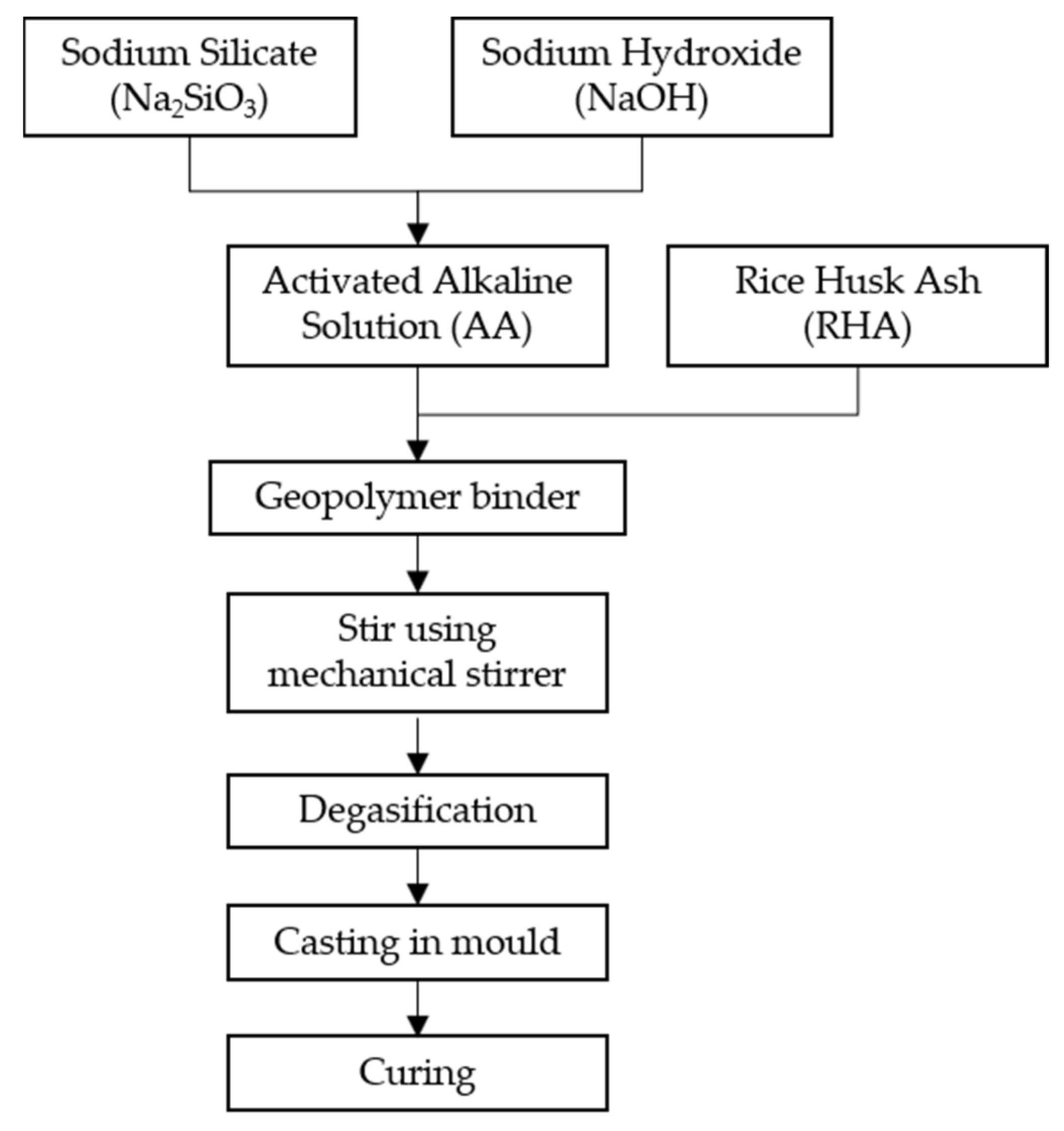
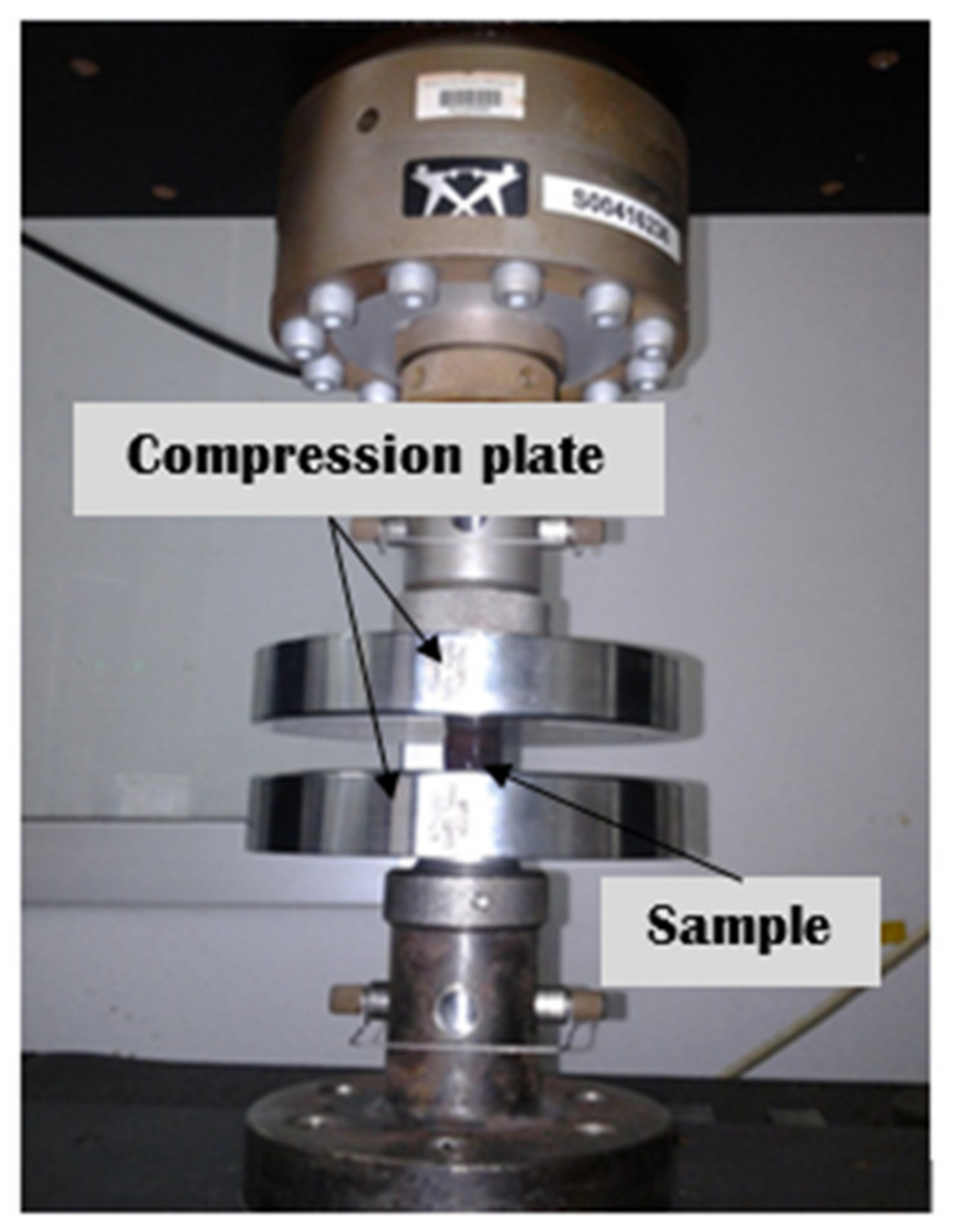

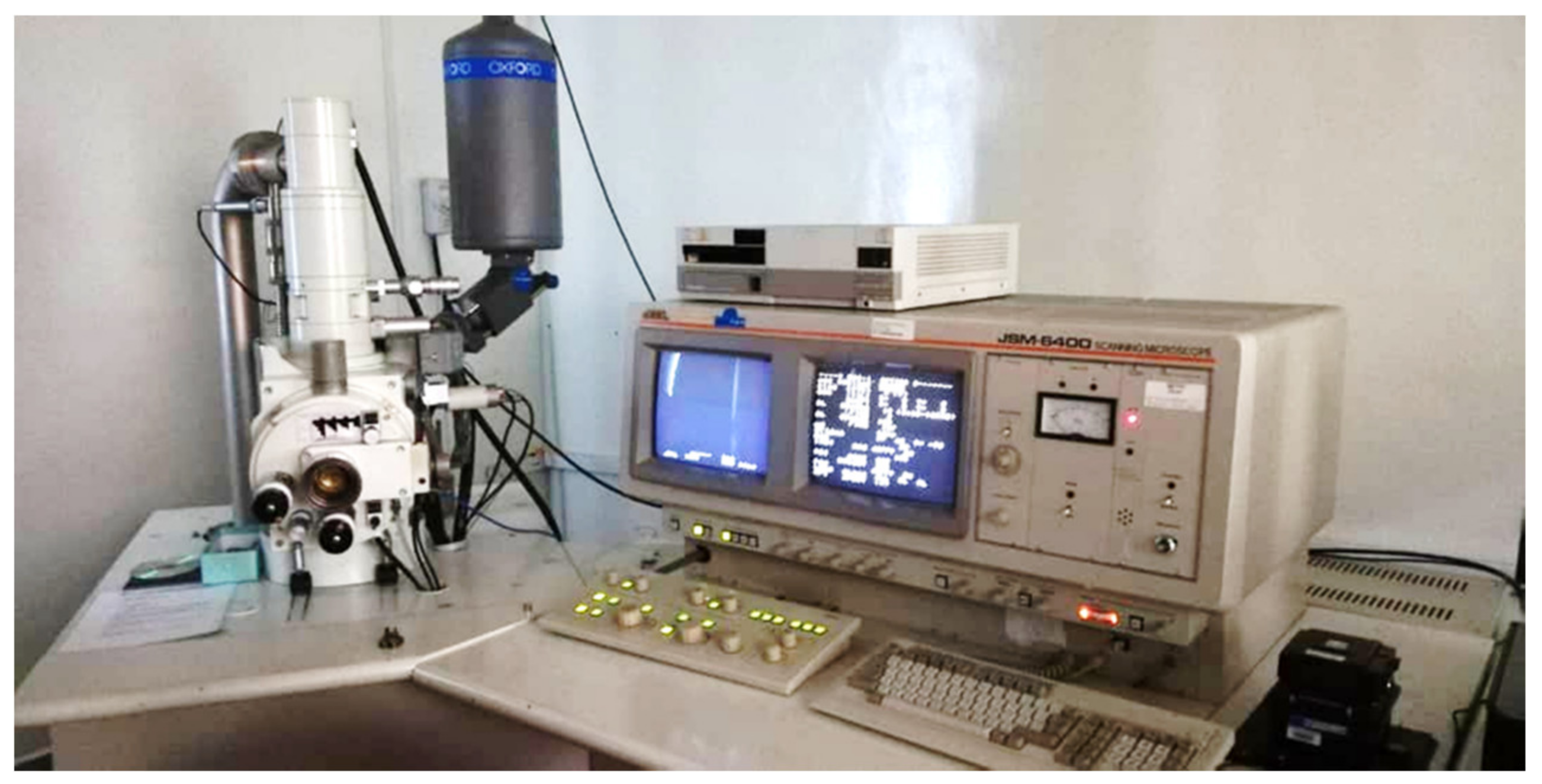



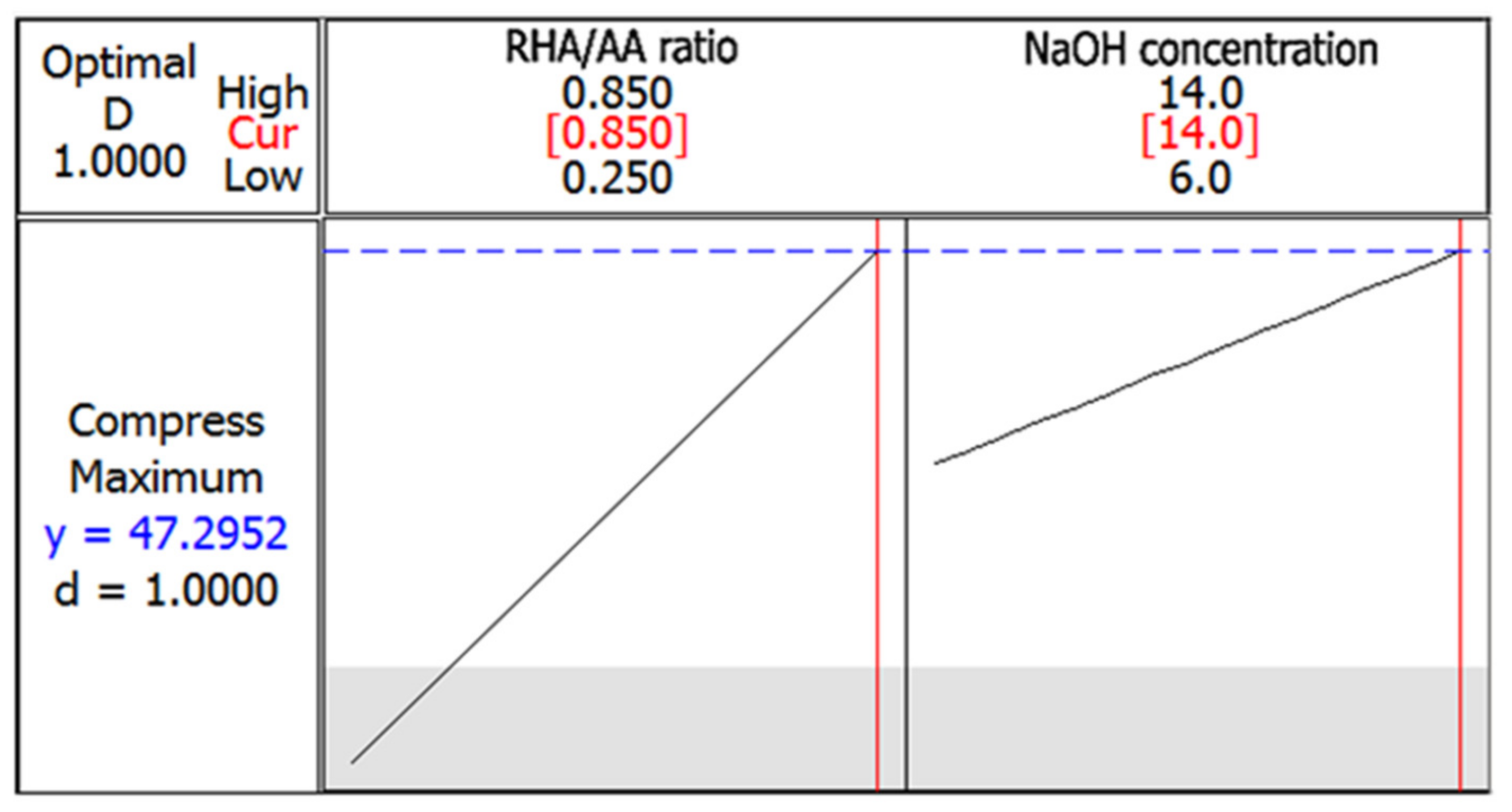
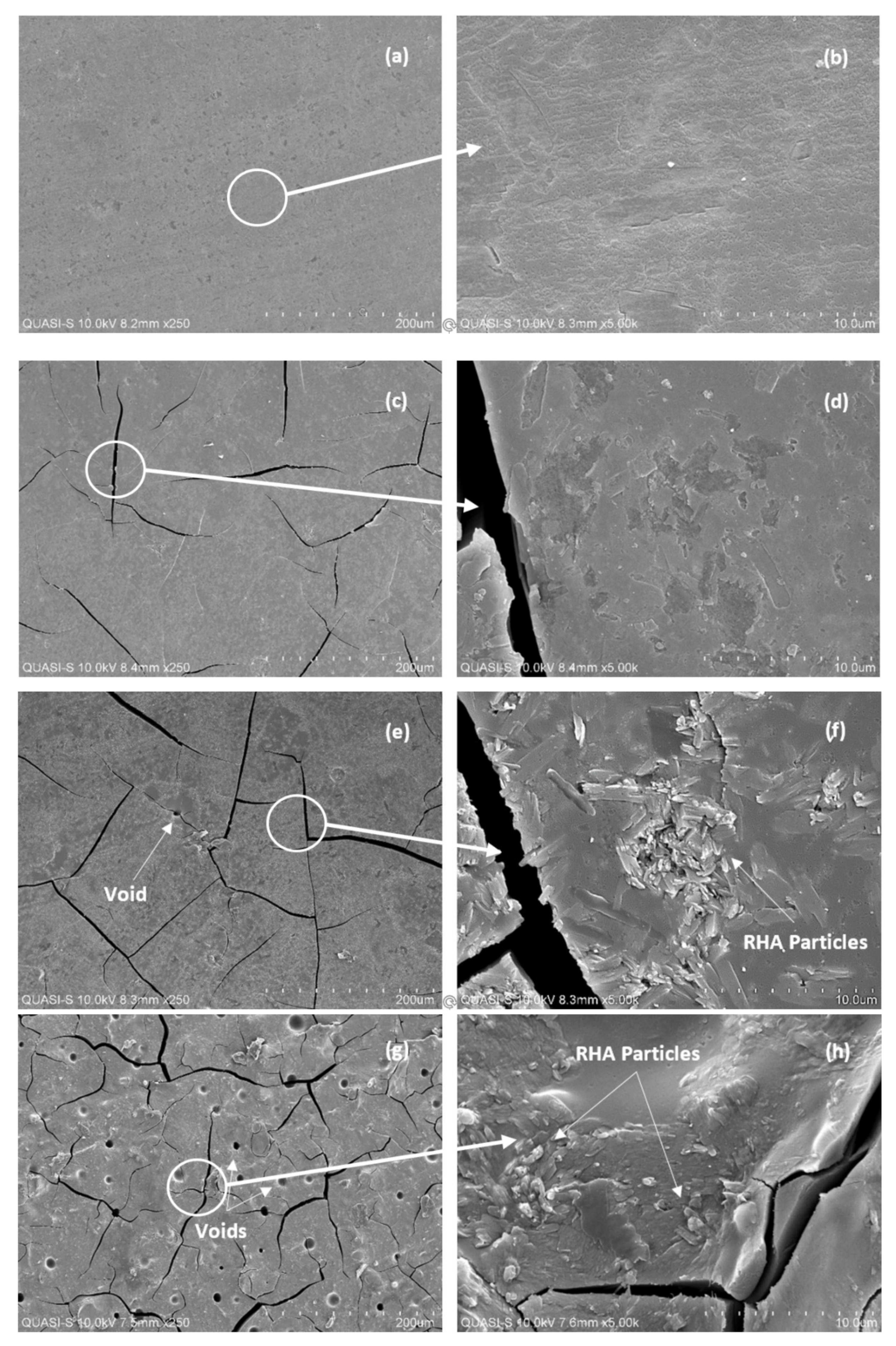
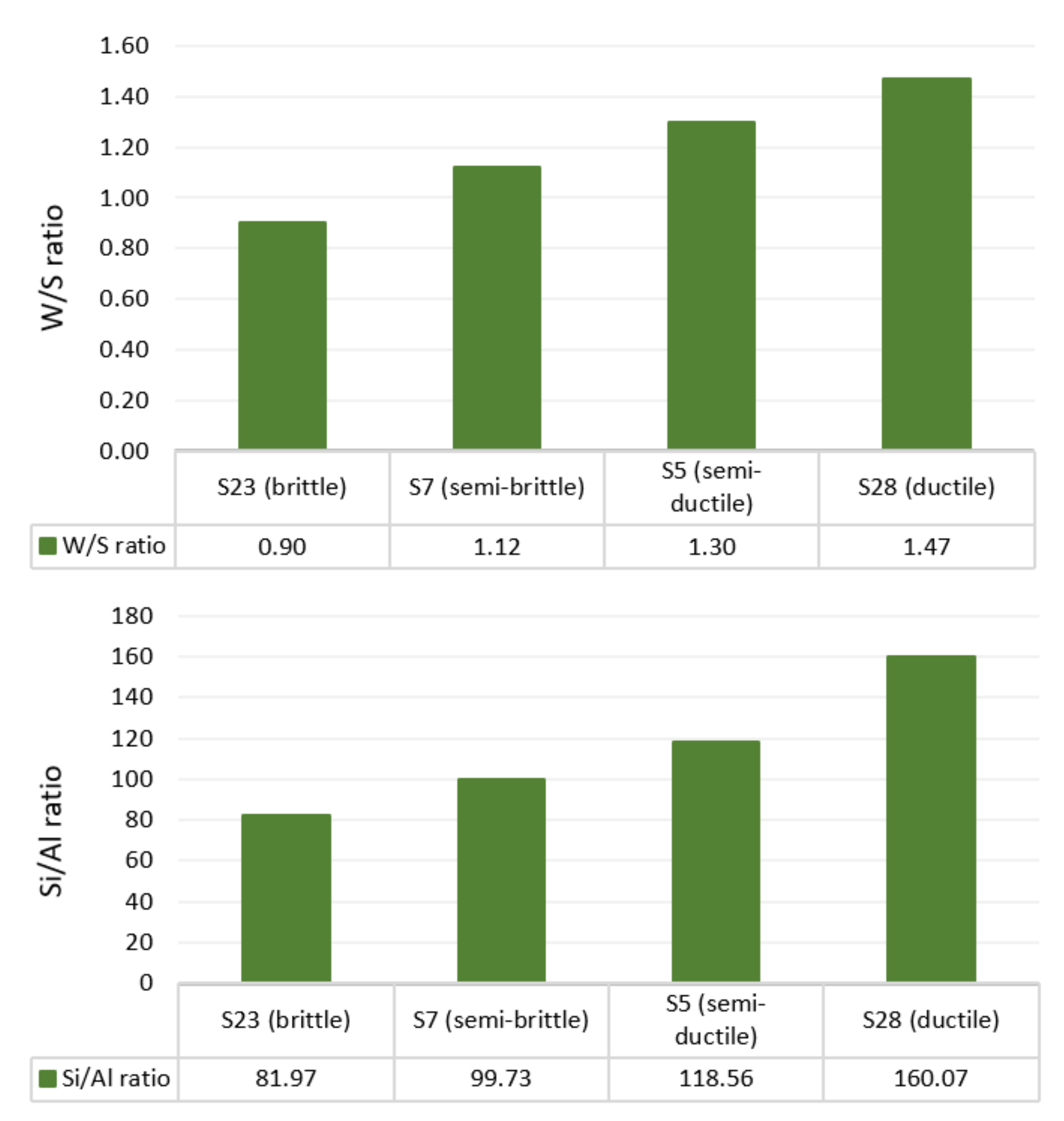



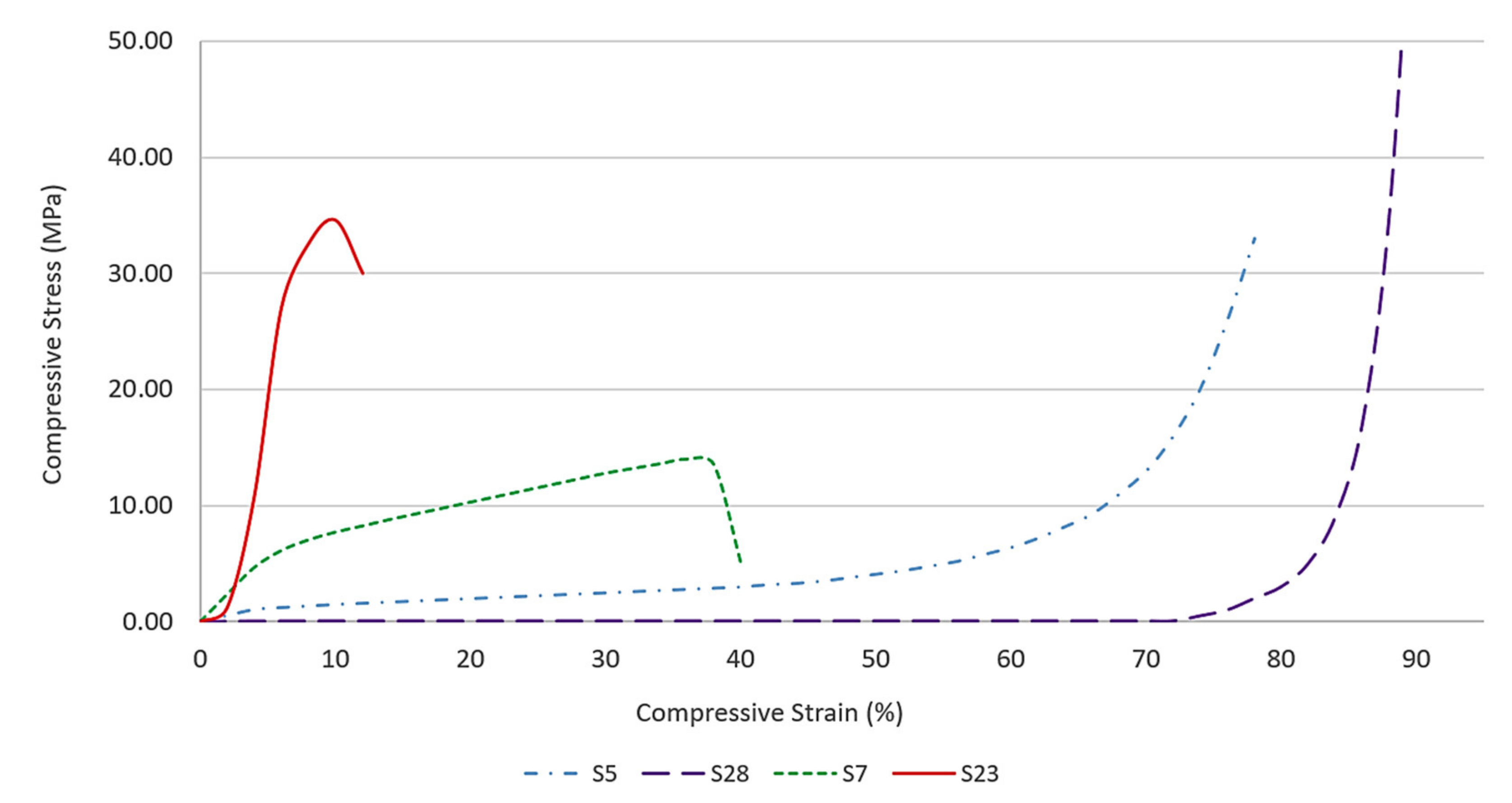

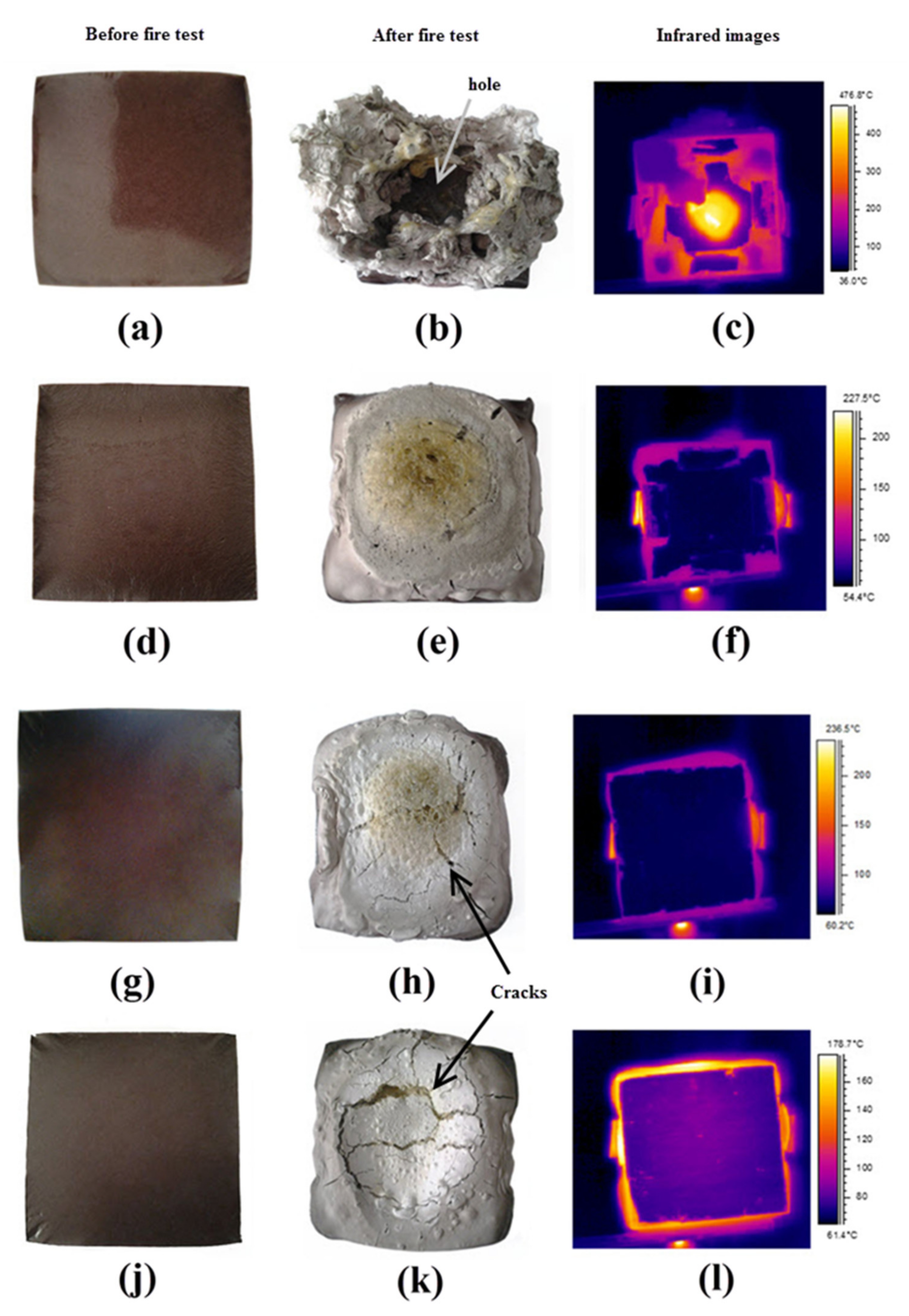

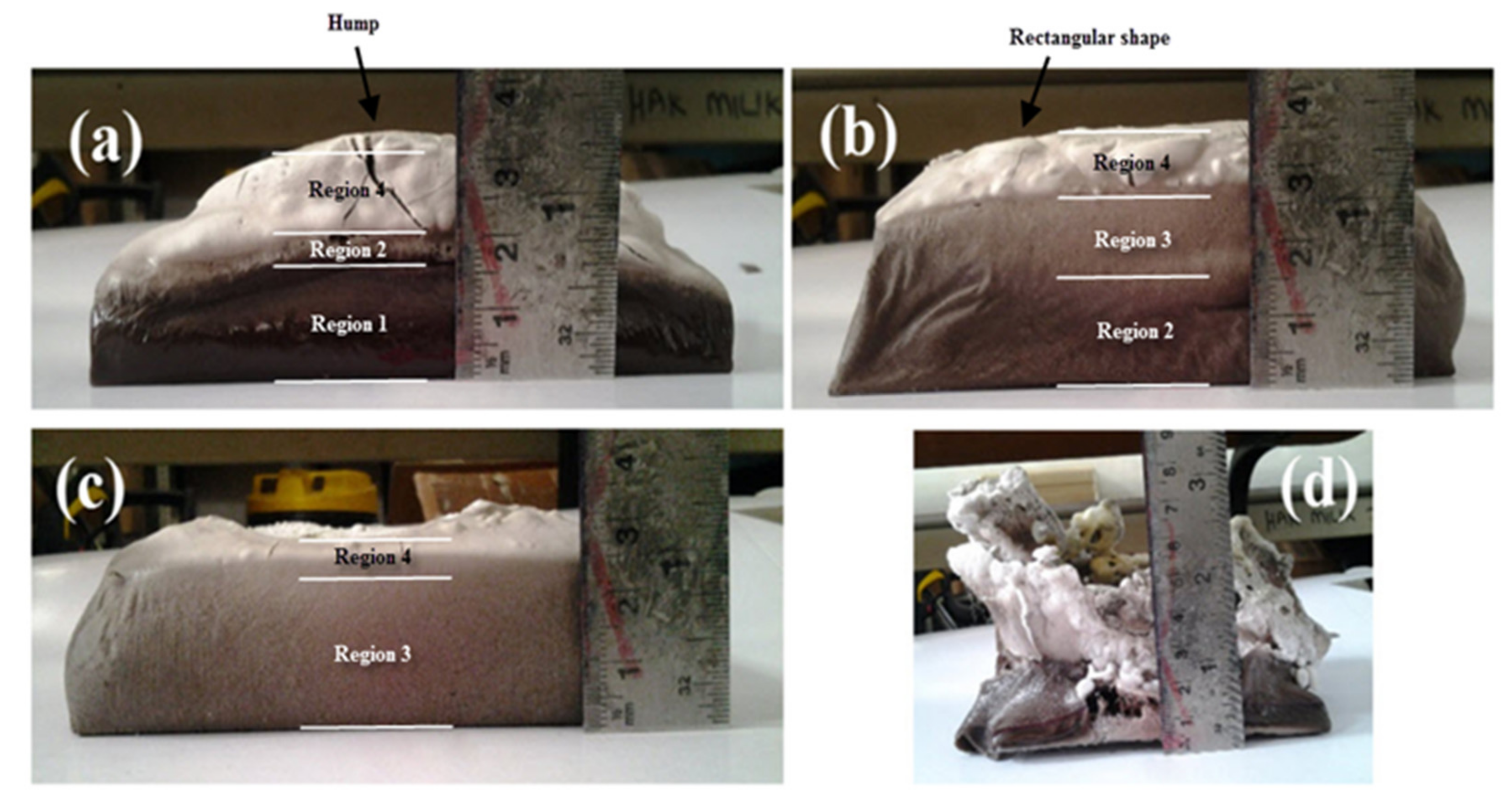

| Design | Factors | |||||
|---|---|---|---|---|---|---|
| 2 | 3 | 4 | 5 | 6 | 7 | |
| RSM (CCD) | 13 | 20 | 31 | 52 | 90 | 152 |
| Full factorial design | 25 | 125 | 625 | 3125 | 15,625 | 78,125 |
| Factor | Unit | Notation | Levels | ||||
| −2 | −1 | 0 | 1 | 2 | |||
| RHA/AA ratio | - | V1 | 0.25 | 0.40 | 0.55 | 0.70 | 0.85 |
| NaOH concentration | M | V2 | 6 | 8 | 10 | 12 | 14 |
| Sample | Coded Factor | Uncoded Factor | ||
|---|---|---|---|---|
| V1 | V2 | V1 | V2 | |
| S1 | −1 | −1 | 0.40 | 8 |
| S2 | 1 | 1 | 0.70 | 12 |
| S3 | 1 | 1 | 0.70 | 12 |
| S4 | 1 | −1 | 0.70 | 8 |
| S5 | −1 | −1 | 0.40 | 8 |
| S6 | −1 | 1 | 0.40 | 12 |
| S7 | 0 | 0 | 0.55 | 10 |
| S8 | 1 | 1 | 0.70 | 12 |
| S9 | 0 | 0 | 0.55 | 10 |
| S10 | −1 | 1 | 0.40 | 12 |
| S11 | 0 | 0 | 0.55 | 10 |
| S12 | 1 | −1 | 0.70 | 8 |
| S13 | −1 | −1 | 0.40 | 8 |
| S14 | 0 | 0 | 0.55 | 10 |
| S15 | 0 | 0 | 0.55 | 10 |
| S16 | −1 | 1 | 0.40 | 12 |
| S17 | 1 | −1 | 0.70 | 8 |
| S18 | 0 | 0 | 0.55 | 10 |
| S19 | 0 | −2 | 0.55 | 6 |
| S20 | 2 | 0 | 0.85 | 10 |
| S21 | −2 | 0 | 0.25 | 10 |
| S22 | 0 | 2 | 0.55 | 14 |
| S23 | 2 | 0 | 0.85 | 10 |
| S24 | 0 | −2 | 0.55 | 6 |
| S25 | −2 | 0 | 0.25 | 10 |
| S26 | 0 | 2 | 0.55 | 14 |
| S27 | 2 | 0 | 0.85 | 10 |
| S28 | −2 | 0 | 0.25 | 10 |
| S29 | 0 | 2 | 0.55 | 14 |
| S30 | 0 | −2 | 0.55 | 6 |
| Properties | RHA |
|---|---|
| Particles Size | <75 µm |
| Color | Light gray |
| Structure | Powder |
| Odor | Non |
| Component. | SiO2 | PdO | Al2O3 | Fe2O3 | CaO | K2O | Cr2O3 | MnO | NiO | CuO | ZnO |
|---|---|---|---|---|---|---|---|---|---|---|---|
| Mass (%) | 87.40 | 6.00 | 3.00 | 1.49 | 1.40 | 0.49 | 0.27 | 0.19 | 0.07 | 0.05 | 0.04 |
| Sample | RHA/AA Ratio (V1) | NaOH Concentration (V2) | RHA/AA Ratio (V1) | NaOH Concentration (V2) | Compressive Strength (MPa) |
|---|---|---|---|---|---|
| S1 | −1 | −1 | 0.40 | 8 | 0.80 |
| S2 | 1 | 1 | 0.70 | 12 | 31.07 |
| S3 | 1 | 1 | 0.70 | 12 | 33.55 |
| S4 | 1 | −1 | 0.70 | 8 | 23.20 |
| S5 | −1 | −1 | 0.40 | 8 | 0.89 |
| S6 | −1 | 1 | 0.40 | 12 | 0.48 |
| S7 | 0 | 0 | 0.55 | 10 | 14.39 |
| S8 | 1 | 1 | 0.70 | 12 | 33.32 |
| S9 | 0 | 0 | 0.55 | 10 | 13.82 |
| S10 | −1 | 1 | 0.40 | 12 | 0.65 |
| S11 | 0 | 0 | 0.55 | 10 | 15.10 |
| S12 | 1 | −1 | 0.70 | 8 | 25.49 |
| S13 | −1 | −1 | 0.40 | 8 | 1.03 |
| S14 | 0 | 0 | 0.55 | 10 | 13.31 |
| S15 | 0 | 0 | 0.55 | 10 | 14.88 |
| S16 | −1 | 1 | 0.40 | 12 | 0.64 |
| S17 | 1 | −1 | 0.70 | 8 | 22.52 |
| S18 | 0 | 0 | 0.55 | 10 | 15.34 |
| S19 | 0 | −2 | 0.55 | 6 | 16.12 |
| S20 | 2 | 0 | 0.85 | 10 | 30.97 |
| S21 | −2 | 0 | 0.25 | 10 | 0.05 |
| S22 | 0 | 2 | 0.55 | 14 | 20.29 |
| S23 | 2 | 0 | 0.85 | 10 | 34.60 |
| S24 | 0 | −2 | 0.55 | 6 | 15.53 |
| S25 | −2 | 0 | 0.25 | 10 | 0.04 |
| S26 | 0 | 2 | 0.55 | 14 | 17.78 |
| S27 | 2 | 0 | 0.85 | 10 | 30.19 |
| S28 | −2 | 0 | 0.25 | 10 | 0.04 |
| S29 | 0 | 2 | 0.55 | 14 | 21.90 |
| S30 | 0 | −2 | 0.55 | 6 | 15.64 |
| Term | Notation | Coefficient | Std. Error of Coefficient | p-Value |
|---|---|---|---|---|
| Constant | 15.700 | 0.6632 | 0.000 | |
| RHA/AA ratio | V1 | 9.886 | 0.5932 | 0.000 |
| NaOH concentration | V2 | 1.421 | 0.5932 | 0.024 |
| RHA/AA ratio*NaOH concentration | V1 * V2 | 2.307 | 1.0274 | 0.034 |
| R2 = 0.9211 R2 (adj) = 0.9085 | ||||
| Sample | Compressive Strength (MPa) | ||
|---|---|---|---|
| Experimental Value | Predicted Value | Error (%) | |
| SV1 | 48.91 | 47.30 | 3.40 |
| SV2 | 48.10 | 47.30 | 1.69 |
| SV3 | 47.12 | 47.30 | 0.38 |
| Error | 1.82 | ||
| Sample | RHA/AA Ratio (V1) | NaOH Concentration (V2) | Compressive Strength (MPa) |
|---|---|---|---|
| S5 | 0.40 | 8 | 0.89 |
| S7 | 0.55 | 10 | 14.39 |
| S23 | 0.85 | 10 | 34.60 |
| S28 | 0.25 | 10 | 0.04 |
| Band | RHA (cm−1) | S23 (cm−1) Brittle | S28 (cm−1) Ductile | Characteristic Bands |
|---|---|---|---|---|
| A | 3153 | 3343 | 3330 | O–H stretching (H2O) |
| B | 1630 | 1638 | 1643 | O–H bending (H2O) |
| C | - | 1406 | 1424 | Si-O/Al-O stretching |
| D | 1087 | 1003 | 978 | Si–O/Al–O stretching |
| E | 797 | 786 | - | Si–O–Si stretching quartz |
| F | - | 568 | 580 | Zeolites |
| G | - | - | 383 | O–Si–O bending (SiO4) |
| Sample | Compressive Strength (MPa) | Location of Si–O–Si (cm−1) | AS Ratio | H Ratio | Si/Al Ratio | W/S Ratio |
|---|---|---|---|---|---|---|
| RHA | - | 1087 | 1.00 | 1.00 | - | - |
| S23 | 33.55 | 1003 | 2.01 | 1.25 | 88.95 | 0.26 |
| S28 | 0.04 | 978 | 2.01 | 1.39 | 160.07 | 0.41 |
Publisher’s Note: MDPI stays neutral with regard to jurisdictional claims in published maps and institutional affiliations. |
© 2021 by the authors. Licensee MDPI, Basel, Switzerland. This article is an open access article distributed under the terms and conditions of the Creative Commons Attribution (CC BY) license (https://creativecommons.org/licenses/by/4.0/).
Share and Cite
Mohd Basri, M.S.; Mustapha, F.; Mazlan, N.; Ishak, M.R. Rice Husk Ash-Based Geopolymer Binder: Compressive Strength, Optimize Composition, FTIR Spectroscopy, Microstructural, and Potential as Fire-Retardant Material. Polymers 2021, 13, 4373. https://doi.org/10.3390/polym13244373
Mohd Basri MS, Mustapha F, Mazlan N, Ishak MR. Rice Husk Ash-Based Geopolymer Binder: Compressive Strength, Optimize Composition, FTIR Spectroscopy, Microstructural, and Potential as Fire-Retardant Material. Polymers. 2021; 13(24):4373. https://doi.org/10.3390/polym13244373
Chicago/Turabian StyleMohd Basri, Mohd Salahuddin, Faizal Mustapha, Norkhairunnisa Mazlan, and Mohd Ridzwan Ishak. 2021. "Rice Husk Ash-Based Geopolymer Binder: Compressive Strength, Optimize Composition, FTIR Spectroscopy, Microstructural, and Potential as Fire-Retardant Material" Polymers 13, no. 24: 4373. https://doi.org/10.3390/polym13244373
APA StyleMohd Basri, M. S., Mustapha, F., Mazlan, N., & Ishak, M. R. (2021). Rice Husk Ash-Based Geopolymer Binder: Compressive Strength, Optimize Composition, FTIR Spectroscopy, Microstructural, and Potential as Fire-Retardant Material. Polymers, 13(24), 4373. https://doi.org/10.3390/polym13244373







